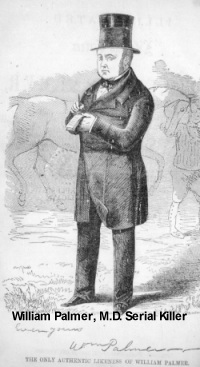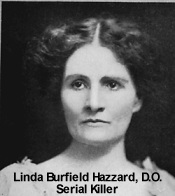|
Links:
 Demon
Doctors:Physicians as Serial Killers
Demon
Doctors:Physicians as Serial Killers
Serial
killers' common characteristics
From:
"Introduction" to Demon Doctors: Physicians as Serial
Killers
By Kenneth V. Iserson, M.D.
Galen Press, Ltd., Tucson, AZ,
Where
lewdness leads to murder, and ends in hanging, the disease and medicine
go together.
- Saturday Review, 1858
 Much
has been written about the sociopathic behaviors of serial killers.
Essentially, sociopaths lack those traits that help people get along
with each other in a society. One of these traits is the ability
to love-serial killers develop no lasting relationships except those
from which they obviously and directly benefit. Sociopaths identify
with aggressive role models, and are only capable of sadomasochistic
relationships based on power. Most are highly impulsive, repeatedly
demonstrate aggressive behavior, and are thrill seekers, constantly
searching for new stimulants. As Ronald Markman, a forensic psychiatrist,
wrote, "They lack the internal prohibitions, or conscience,
that keep most of us from giving full expression to our most primitive,
and sometimes violent impulses." Much
has been written about the sociopathic behaviors of serial killers.
Essentially, sociopaths lack those traits that help people get along
with each other in a society. One of these traits is the ability
to love-serial killers develop no lasting relationships except those
from which they obviously and directly benefit. Sociopaths identify
with aggressive role models, and are only capable of sadomasochistic
relationships based on power. Most are highly impulsive, repeatedly
demonstrate aggressive behavior, and are thrill seekers, constantly
searching for new stimulants. As Ronald Markman, a forensic psychiatrist,
wrote, "They lack the internal prohibitions, or conscience,
that keep most of us from giving full expression to our most primitive,
and sometimes violent impulses."
 Sociopaths
also are inherently sadistic, and fascinated by violence, injury,
and torture. As Holmes & De Burger noted, Ted Bundy exemplified
the classic sociopathic aspects of the serial killer: he was unable
to love and had a sadistic nature, combined with anti-social personality
traits such as an evasive personality, strong feelings of insecurity,
general anger, and a tendency to run from problems. Between 3 and
5 percent of men are sociopaths, although this is true of considerably
less than 1 percent of females. Not all sociopaths, however, are
killers; many become successful in business or are world leaders. Sociopaths
also are inherently sadistic, and fascinated by violence, injury,
and torture. As Holmes & De Burger noted, Ted Bundy exemplified
the classic sociopathic aspects of the serial killer: he was unable
to love and had a sadistic nature, combined with anti-social personality
traits such as an evasive personality, strong feelings of insecurity,
general anger, and a tendency to run from problems. Between 3 and
5 percent of men are sociopaths, although this is true of considerably
less than 1 percent of females. Not all sociopaths, however, are
killers; many become successful in business or are world leaders.
Serial killers tend
to be male, white, 25 to 34 years old, lower to middle class, intelligent
or at least "street smart," charming and charismatic,
and police "groupies" orinterested in police work. As
illustrated in many of the physicians' stories in this book, as
they progress in their killings, they experience a degeneration
of their personalities, take less time planning their crimes, have
less time between killings, and increase their levels of violence.
Often, they collect newspaper clippings or mementos that document
their exploits, so that they can repeatedly use them to relive their
fantasies during their "cooling-off periods."
Most serial killers,
will not speak in detail about their crimes or motivation. John
Douglas, the FBI's legendary profiler, however, could sometimes
get them to talk by asking them to speculate about what "the
killer" might have been thinking-that is, to speak about themselves
in the third person. Ronald Holmes actually persuaded one serial
killer to let him tape an interview on condition of anonymity. Holmes
published part of the interview in his book, Profiling Violent
Crimes: An Investigative Tool. As that killer said:
 This
need for self-magnification is always, I believe, a mandatory
prerequisite to any episode of violence. Just prior to his every
decision to victimize, a serial killer always first experiences
a sudden and precipitous psychological fall, an extreme low, which
he can neither tolerate nor deal with in any rational fashion.
Throughout his day-to-day existence, all of his meaning is derived
from the fact that he thinks himself profoundly special, unique,
and perfect over all other human beings on the face of the earth
. . . The acting out of his cherished fantasies, he knows, will
elevate him from his intolerable and infuriating psychological
low; they will make things "all right" and cause him
to feel good about himself; they will "prove," without
any shadow of doubt, that he is really somebody . . . This
need for self-magnification is always, I believe, a mandatory
prerequisite to any episode of violence. Just prior to his every
decision to victimize, a serial killer always first experiences
a sudden and precipitous psychological fall, an extreme low, which
he can neither tolerate nor deal with in any rational fashion.
Throughout his day-to-day existence, all of his meaning is derived
from the fact that he thinks himself profoundly special, unique,
and perfect over all other human beings on the face of the earth
. . . The acting out of his cherished fantasies, he knows, will
elevate him from his intolerable and infuriating psychological
low; they will make things "all right" and cause him
to feel good about himself; they will "prove," without
any shadow of doubt, that he is really somebody . . .
The specific methods
of violence he chooses to act out, then, are perceived as "good"
and "righteous," perfectly appropriate for the present,
as they have already been tried and tested in the imagination
for their ability to restore his feelings of supremacy . . . The
consequences of this outlook are that the struggles, the pain,
and the outcries of a serial killer's victim inspire nothing in
the way of pity; his victim is a worthless object, wholly depersonalized,
and is therefore ineligible for such a human expression as pity
. . . His victim's misery is the elixir that thrills him beyond
all measure, for it is his tangible assurance that all is proceeding
according to his well-ordered plan; it is his visible "evidence"
that he is the magnificent, all-powerful creature he always knew
himself to be.
In
the final analysis, all serial killers, including those in this
book, have one thing in common: they kill many people for their
own gratification.
©Galen
Press, Ltd., 2001
|
 EXTRAS
EXTRAS

 Much
has been written about the sociopathic behaviors of serial killers.
Essentially, sociopaths lack those traits that help people get along
with each other in a society. One of these traits is the ability
to love-serial killers develop no lasting relationships except those
from which they obviously and directly benefit. Sociopaths identify
with aggressive role models, and are only capable of sadomasochistic
relationships based on power. Most are highly impulsive, repeatedly
demonstrate aggressive behavior, and are thrill seekers, constantly
searching for new stimulants. As Ronald Markman, a forensic psychiatrist,
wrote, "They lack the internal prohibitions, or conscience,
that keep most of us from giving full expression to our most primitive,
and sometimes violent impulses."
Much
has been written about the sociopathic behaviors of serial killers.
Essentially, sociopaths lack those traits that help people get along
with each other in a society. One of these traits is the ability
to love-serial killers develop no lasting relationships except those
from which they obviously and directly benefit. Sociopaths identify
with aggressive role models, and are only capable of sadomasochistic
relationships based on power. Most are highly impulsive, repeatedly
demonstrate aggressive behavior, and are thrill seekers, constantly
searching for new stimulants. As Ronald Markman, a forensic psychiatrist,
wrote, "They lack the internal prohibitions, or conscience,
that keep most of us from giving full expression to our most primitive,
and sometimes violent impulses."  Sociopaths
also are inherently sadistic, and fascinated by violence, injury,
and torture. As Holmes & De Burger noted, Ted Bundy exemplified
the classic sociopathic aspects of the serial killer: he was unable
to love and had a sadistic nature, combined with anti-social personality
traits such as an evasive personality, strong feelings of insecurity,
general anger, and a tendency to run from problems. Between 3 and
5 percent of men are sociopaths, although this is true of considerably
less than 1 percent of females. Not all sociopaths, however, are
killers; many become successful in business or are world leaders.
Sociopaths
also are inherently sadistic, and fascinated by violence, injury,
and torture. As Holmes & De Burger noted, Ted Bundy exemplified
the classic sociopathic aspects of the serial killer: he was unable
to love and had a sadistic nature, combined with anti-social personality
traits such as an evasive personality, strong feelings of insecurity,
general anger, and a tendency to run from problems. Between 3 and
5 percent of men are sociopaths, although this is true of considerably
less than 1 percent of females. Not all sociopaths, however, are
killers; many become successful in business or are world leaders.
 This
need for self-magnification is always, I believe, a mandatory
prerequisite to any episode of violence. Just prior to his every
decision to victimize, a serial killer always first experiences
a sudden and precipitous psychological fall, an extreme low, which
he can neither tolerate nor deal with in any rational fashion.
Throughout his day-to-day existence, all of his meaning is derived
from the fact that he thinks himself profoundly special, unique,
and perfect over all other human beings on the face of the earth
. . . The acting out of his cherished fantasies, he knows, will
elevate him from his intolerable and infuriating psychological
low; they will make things "all right" and cause him
to feel good about himself; they will "prove," without
any shadow of doubt, that he is really somebody . . .
This
need for self-magnification is always, I believe, a mandatory
prerequisite to any episode of violence. Just prior to his every
decision to victimize, a serial killer always first experiences
a sudden and precipitous psychological fall, an extreme low, which
he can neither tolerate nor deal with in any rational fashion.
Throughout his day-to-day existence, all of his meaning is derived
from the fact that he thinks himself profoundly special, unique,
and perfect over all other human beings on the face of the earth
. . . The acting out of his cherished fantasies, he knows, will
elevate him from his intolerable and infuriating psychological
low; they will make things "all right" and cause him
to feel good about himself; they will "prove," without
any shadow of doubt, that he is really somebody . . .